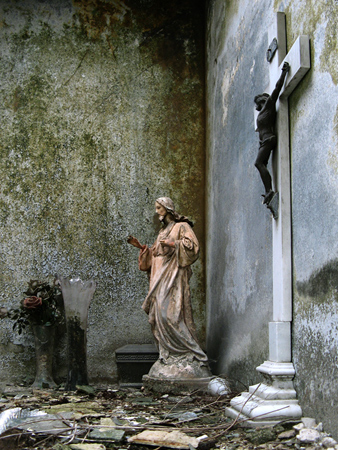
Documenting Recoleta Cemetery in Buenos Aires since 2007
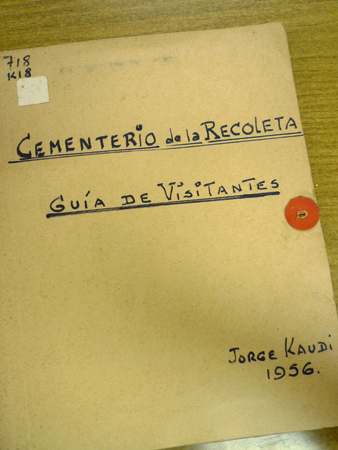
The first attempt to create a Recoleta Cemetery guidebook appeared in 1955, ten years after a few tombs were declared historic monuments by the national heritage association. Author Jorge Kaudi worked in the mausoleum business & assembled several lists of noteworthy tombs in Recoleta Cemetery. His goal was to generate interest in a larger, more scholarly project to be used by school teachers… teachers who would ultimately use the cemetery as a big, outdoor classroom for teaching art, architecture & national history. Very cool.
Kaudi’s hopes that the Ministry of Education would continue his project never came to fruition. But his efforts led to a mention in local newspapers & generated demand for new copies of the list. The one appearing in this post was typed by Kaudi in 1956, signed & donated to the library of the Museo de Arte Popular-José Hernández. Apparently it’s the only original left in any of the city’s libraries:
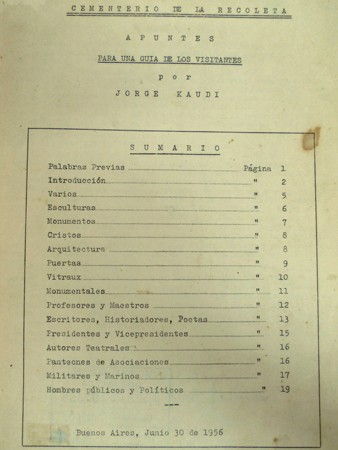
Kaudi recognized the difficulty of designing a cemetery guidebook since passageways inside have no names. Providing written directions to specific loactions is impossible, so he chose to use the cemetery’s official location system instead. Kaudi created categories & listed several entries under each:
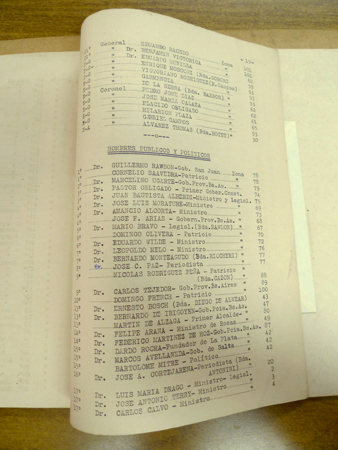
Fairly extensive (the entire document is 20 pages), the list is an incredible effort for the post-Perón era. But the most interesting section is the introduction, where Kaudi makes a series of observations concerning tourism in Recoleta Cemetery:
As I mentioned before, no guidebook exists for Recoleta Cemetery, not even a bad one. All the artistic treasure it contains, which constitute its rich historical & cultural heritage, remains ignored by many people who visit it.
American & English tourism companies classify this cemetery as monumental & very worthy of being visited. For that reason, one of the first sites for tourists to see in the city of Buenos Aires is this cemetery. Guided by translators who must fulfill their duty according to rigid schedules, [they] abbreviate its visit, barely arriving to the monument to Dr. Carlos Pelligrini situated 100 meters from the entrance.
With little exception, visitors do not make contact with the exciting reality of our history due to the lack of knowledgable guides who do not know our past history, its most glorious traditions, or its valued forefathers. Without doubt, those who should praise our past & take real pride in extolling the virtures of our founders unfortunately fail. And worse, along with this ignorance of history, there are single-minded guides who ignore artistic & esthetic topics… all of which demonstrate the sad fact that they cannot explain to visitors knowledge they do not possess. Tourists return to their own countries without a good art & history lesson… something that anyone has a right to experience who visits a country with interest to see & appreciate something that tourist agencies claim worthy of admiration.
Kaudi cuts right to the point… he could be talking about today! At least a couple of books about Recoleta Cemetery exist today (we will release our own guidebook soon), & there are a few good tour guides. Hopefully this blog fulfills some of what Kaudi considered appropriate over 50 years ago.
Update (18 May 2011): Wandering through the cemetery in Mar 2011, I stumbled upon a mausoleum designed by Jorge Kaudi. The burial place of J. Rodolfo Bernasconi y Familia deserves a post of its own, but this proves there is always something to discover in Recoleta Cemetery:
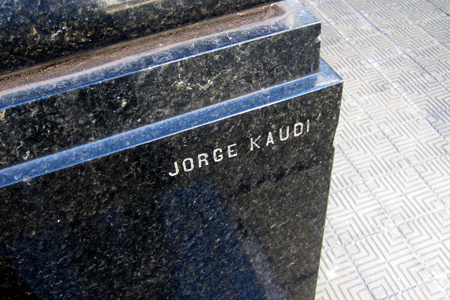
Update (20 Feb 2024): Fourteen years after my original discovery, a group of three researchers found additional information about Kaudi & republished his original work. Marcelo wrote about their journey in this post.
Leave a Comment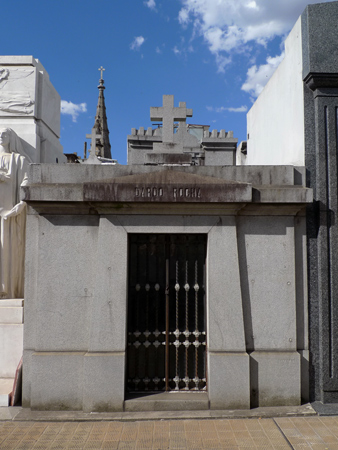
In Recoleta Cemetery, several tombs have been “vacated” by their former residents. Most, as with José de San Martín’s parents, have been returned to the place they were from. But that is not the case with Dardo Rocha, one of the most active politicians of the 19th century & founder of the city of La Plata.
Born in Buenos Aires in 1838, Rocha studied law & like almost all politicians of the era, first joined the military. He fought in the War of the Triple Alliance, where he was badly injured in the battle Curupaytí… the same skirmish where the adopted son of Domingo Faustino Sarmiento died. Rocha later occupied several government positions, but he is most remembered for his role in the foundation of the capital of Buenos Aires Province.
After the 1880 Revolution which officially separated the city of Buenos Aires from its province, Governor Rocha needed to create a new city to house provincial authorities. A commission began searching for different locations for the new city, prioritizing the terrain & easy connection to Buenos Aires. Dolores, Quilmes & Chascomús were options but in the end Ensenada was chosen for its proximity to the river & already having a rail line in service. The city would be built from scratch & Pedro Benoit, a personal friend of Rocha, was invited to design it.
With a big inauguration party, the foundation stone was placed on Novemeber 19, 1882… the birthday of Ponciano, youngest son of Dardo Rocha. The painting below, based on a photograph by Thomas Bradley, records the events of that day:
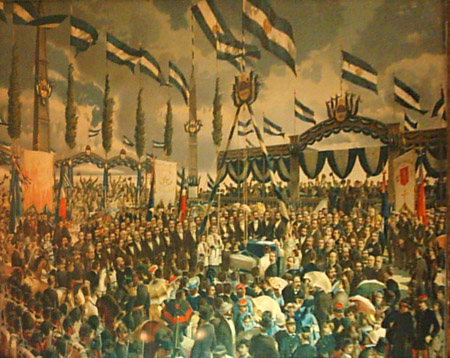
President Julio Argentino Roca was absent with no explanation & was instead represented by Minister Victorino de La Plaza. The distance between Rocha & the President became evident in 1886, when Roca decided to support instead his brother-in-law Miguel Juárez Celman as presidential candidate.
Retired from public life & a widower since 1917, Rocha passed away in his Buenos Aires residence in 1921. After the home wake, his remains were taken to Recoleta Cemetery two days after his death. The Province of Buenos Aires governor sent a telegraph to Rocha’s son, stating that Dardo Rocha should be laid to rest in La Plata. But the request was denied since Rocha’s will expressly stated that he be buried in the family vault in Recoleta alongside his wife.
In 1940 it was decided to transfer Rocha’s remains to the city he founded more than half a century earlier… even though it was not his final wish. A commission composed of influential people & city institutions received the caskets of Dardo Rocha & his wife with great ceremony. Below is the funeral coach parading through the city center:
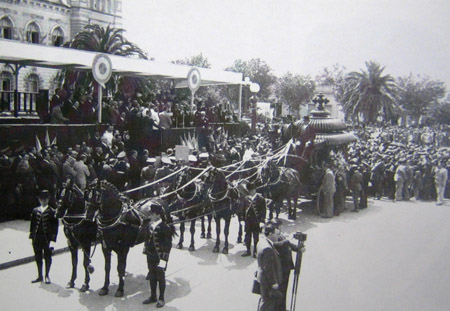
The caskets were later deposited in a crypt built beneath the La Plata cathedral:
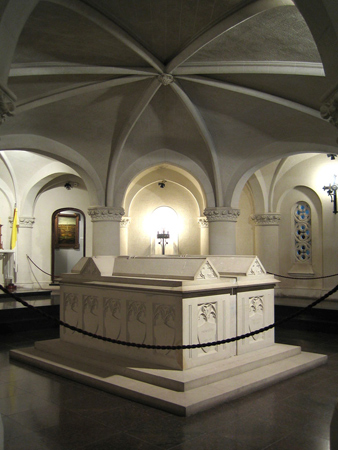
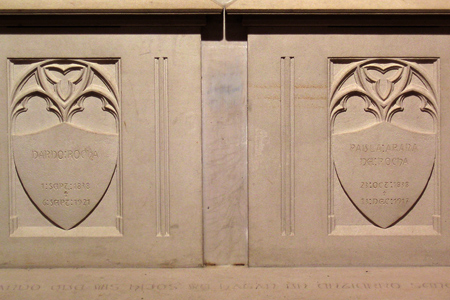
———————————————————
Update (08 Dec 2011): Marcos Arana Panissal, who claims to be a direct descendant of Dardo Rocha, filed a request yesterday with the Archdiocese of La Plata to remove his ancestor’s remains (& those of his wife) from the cathedral crypt to a more prominent location. Panissal also claims that Rocha was not a practicing Catholic, so the current burial spot is inappropriate. While city officials check genealogy, Monsignor Raúl Gross finds the request odd… especially because every November 19th (the day La Plata was founded), many of Rocha’s descendants participate in a commemorative mass held in his honor. Stay tuned & click here to read the entire article (in Spanish).
2 Comments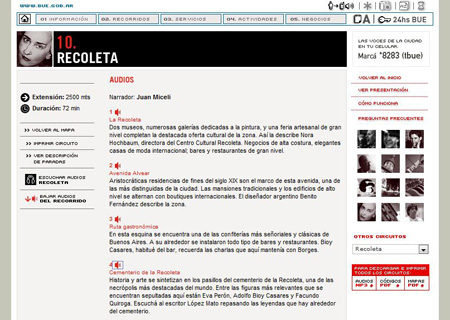
How a city chooses to promote tourism often reflects its own self-image. After the 2001 economic crisis & following devaluation, Buenos Aires became a very popular destination: exotic & affordable. Naturally, the city government jumped on the tourism bandwagon & developed an extensive website to provide information about Buenos Aires to visitors. In our opinion, they did a spectacular job in a short period of time.
The website included a series of audiotours available for download, one in particular focusing on the neighborhood of Recoleta. Although basic, it introduces visitors to the general layout of the area. As for the cemetery, no separate audiotour was available… but three minutes (of that 72-minute recording) are dedicated to the most popular attraction in Buenos Aires. Text on the webpage describes the site:
Historia y arte se sintetizan en los pasillos del cementerio de la Recoleta, una de las necrópolis más destacadas del mundo. Entre las figuras más relevantes que se encuentran sepultadas aquí están Eva Perón, Adolfo Bioy Casares y Facundo Quiroga. Escuchá al escritor López Mato repasando las leyendas que hay alrededor del cementerio.
History & art are summed up in the passageways of Recoleta Cemetery, one of the most notable necropoles in the world. Among the most relevant figures buried here are Eva Perón, Adolfo Bioy Casares, & Facundo Quiroga. Listen to author López Mato recount stories about the cemetery.
Spanish speakers can listen to the three-minute segment below. Strangely, the text above lists Bioy Casares & Quiroga as noteworthy, but they are not mentioned in the audio… a minor oversight but Sarmiento would be better to highlight than Quiroga:
For non-Spanish speakers: According to the audioguide, the most important people in Argentine history are buried in Recoleta Cemetery. No doubt. Its architecture is important & over 70 tombs have been declared National Historic Monuments. Good so far. Omar López Mato discusses the meaning behind the dates inscribed on the floor of the main entrance. Not so important but fine to mention. Eva Perón is here, important for her social work & fight for women’s right to vote. Then López Mato tells the urban legend surrounding Rufina Cambacérès. What’s a cemetery without a few urban legends?
However… No mention is made about restoration works in progress. There is no discussion about the origins of the cemetery. And probably the worst omission is that no effort is made to convey a sense of all the historical sagas contained within its walls.
Like no other cemetery in the world, Recoleta wraps up almost 200 years of national drama… Rosas, Lavalle & Dorrego all wound up in the same place. Juárez Celman, Roca, Pellegrini, Alem, & Campos are all neighbors (well, JC has since been moved). Aramburu, Lonardi, & Evita rest in peace together. I doubt they ever thought they would all end up in the same spot. Anyone who knows minimal Argentine history cannot ignore the irony of that.
A visit to Recoleta Cemetery should remind visitors that the same fate awaits us all —friends & enemies alike— & turn that observation into a lesson about Argentine history. It’s a twist that few tour guides or authors emphasize & doing so would present a more complete image of the city & the nation.
Leave a Comment